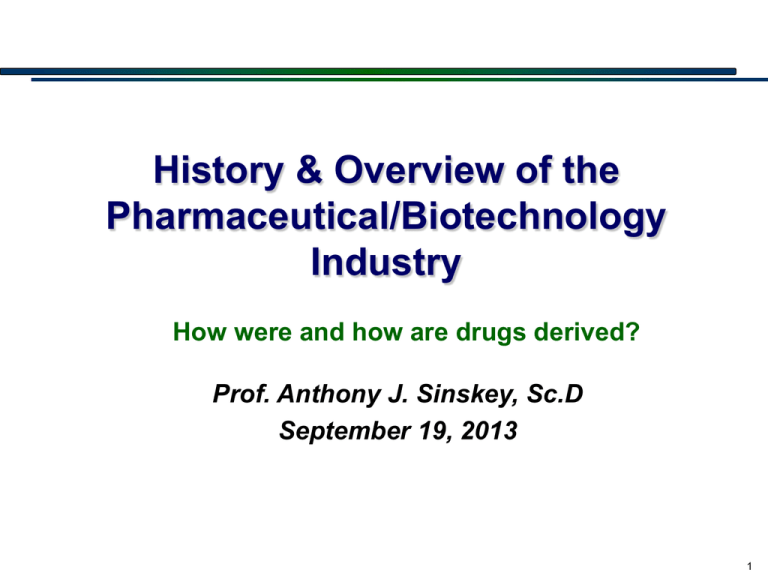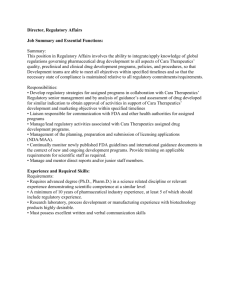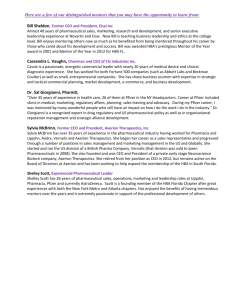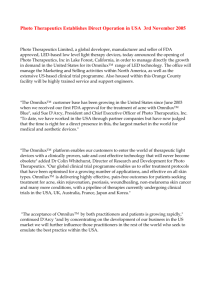History & Overview of the Pharmaceutical/Biotechnology Industry
advertisement

History & Overview of the Pharmaceutical/Biotechnology Industry How were and how are drugs derived? Prof. Anthony J. Sinskey, Sc.D September 19, 2013 1 Therapeutics in the 19th Century • Scurvy – Lind 1763 • Infectious diseases • Vaccination - Jenner 1798 • Cholera - turning off Broad Street pump 1854 • Antiseptic techniques - Lister 1867 • Nonexistent until end of 19th century 2 Digitalis • The first medicines were plants • The first prescribed botanical therapeutic was Digitalis purpurea, a known herbal remedy studied for dose range and toxicities by William Withering • Withering officially described his foxglove prescription in 1785 Image is in the public domain. • Digitalis, the active ingredient from the purple foxglove, is still often used for controlling heart rate http://www.bris.ac.uk/Depts/Chemistry/MOTM/digitalis/digtalis.htm 3 "Digoxigen acsv" by Calvero - Own work. Licensed under Public domain via Wikimedia Commons. Some Plant-Derived Pharmaceuticals Drug Chemical Indication Plant producer Aspirin Salicylate Analgesic, anti-inflammatory Salix alba (white willow tree) Filipendula ulmaria (meadowsweet) Caffeine Xanthine Increases mental alertness Camellia sinensis Cocaine Alkaloid Ophthalmic anesthetic Erythoxylum coca (coca leaves) Codeine Alkaloid Analgesic, cough suppressor Papaver somniferum (opium poppy) Dicoumarol Coumarin Anticoagulant Melilotus officinalis Digoxin Steroid Increases heart muscle contraction Digitalis purpurea (purple foxglove) Ipecac Alkaloid Induces vomiting Psychotria ipecacuanha Morphine Alkaloid Analgesic Papaver somniferum (opium poppy) Pseudoephedrine Alkaloid Clears nasal congestion Ephedra sinica Quinine Alkaloid Malaria Cinchona pubescens (fever tree) Reserpine Alkaloid Antihypertensive Rauvolfia serpentina (Indian snakeroot) Scopalamine Alkaloid Motion sickness Datura stramonium (Jimson weed) Paclitaxel Terpenoid Ovarian, lung, breast cancer Taxus brevifolia (western yew tree) Theophylline Xanthine Anti-asthmatic, diuretic Camellia sinensis Vincristine Alkaloid Leukaemia Catharanthus roseus (rosy periwinkle) 4 An Industry Begins to Emerge 5 Morphine • Alkaloid derived from an organic acid extracted from poppy juice • Friedrich Wilhelm Sertürner in 1815 "Morphin - Morphine" by NEUROtiker0 - Own work. Licensed under Public domain via Wikimedia Commons. 6 Morphine Derivatives HO O H H H N CH3 HO O H3 C O H3 C O O H H H O N O CH3 HO CODEINE (methyl-ether morphine) H3C H H H N CH3 O HEROIN (diacetyl morphine) 7 Late 19th Century Nascent pharmaceutical industry grew from established dye-producing industry where organic synthesis to create new molecules and production processes for making them matured. Aniline purple (mauve), the first synthetic dye, was discovered in 1856 by Sir William Henry Perkin as he worked with coal tar derivatives trying to synthesize quinine. Perkin commercialized mauve, creating the industrial-scale fine chemical production industry. Image is in the public domain. 8 Paclitaxel • Extracted from yew trees • Discovered in the 1960s by National Cancer Institute • 1983 – antitumor trials in humans began • 1991 – Bristol-Myers Squibb obtained rights to produce Taxol Image removed due to copyright restrictions. Plantation-grown yew trees. Natural Pharmaceuticals Photo. See: http://pubs.acs.org/email/cen/html/090804094313.html. Courtesy of R. Terrett on Wikimedia Commons. Image is in the public domain. Natural Pharmaceuticals, Inc. – harvesting plantation grown yew trees. http://pubs.acs.org/email/cen/html/090804094313.html 9 Dyes and Medicine • Differential staining of tissues and cells led Paul Ehrlich to speculate that “chemoreceptors” on cells affected how cells responded to chemicals. • Later, Ehrlich extended this idea to pathogens noting that chemical structures should differentially affect host and pathogen tissues, providing a basis for “chemotherapy”, or using chemicals to treat disease. Image removed due to copyright restrictions. Slide showing skull tissue stained with Mallory triple stain. See: https://casweb.ou.edu/pbell/histology/Captions /Cellmethods/16.Mallory.html • Major therapeutic success was Salvarsan, first drug for syphilis, marketed in 1910. http://www.nobel.se/medicine/laureates/1908/ehrlich-bio.html http://www.chemheritage.org/EducationalServices/chemach/ppb/pe.html http://casweb.ou.edu/pbell/Histology/Outline/contents.html 10 Arsphenamine The structure of Arsphenamine has been proposed to be akin to the azobenzene (A), but mass spectral studies published in 2005 suggest it is actually a mixture of the trimer B and the pentamer C. Also known as Salvarasan and compound 606 – Arsphenamine was introduced in the 1910s as the first effective treatment for syphilis. Wikipedia.org 11 Salvarsan treatment kit for syphilis Courtesy of Wellcome Images on Wikimedia Commons. CC BY license. This file comes from Wellcome Images, a website operated by Wellcome Trust, a global charitable foundation based in the United Kingdom. Germany, 1909-1912: The kit included tools to help prepare injections for treatment of syphilis. 12 Pharmaceuticals Extracted from Biological Source (some protein-based examples produced using genetic engineering) Substance Medical application Blood products (e.g. coagulation factors Treatment of blood disorders such as hemophilia A or B Vaccines Vaccination against various diseases Antibodies Passive immunization against various diseases Insulin Treatment of diabetes mellitus Enzymes Thrombolytic agents, digestive aids, debriding agents (i.e. cleansing of wounds) Antibiotics Treatment against various infectious agents Plant extractives (e.g. alkaloids) Various, including pain relief 13 • • • • • • • • Eli Lilly & Company Founded in May, 1876 by Colonel Eli Lilly, a pharmaceutical chemist 1886, chemist Ernest Eberhard joined Lilly from Purdue 1923, introduced Iletin, world’s first insulin product 1940s, became active in antibiotics; helped develop method to mass produce penicillin 1950s, develops vancomycin followed by erythromycin 1980s, issues with Darvon, a painkiller alleged to be addictive – deaths associated with overdoses; launches Humulin® insulin (rDNA production of insulin) and Prozac® 1982, Oraflex, an arthritis drug, taken off market after it’s linked to 50+ deaths - pleads guilty to 25 misdemeanor criminal counts 2013, filed $500 million international lawsuit with NAFTA against Canada, alleging they invalidated patents for its drugs Straterra and Zyprexa Image removed due to copyright restrictions. Illustration of the pure active form of insulin. See: http://customers.hbci.com/~wenonah/gif/aminose2.jpg. 14 Convergence of Disciplines Analytical chemistry for isolating and purifying compounds from biological sources Organic synthesis for making compounds Pharmaceutical Industry Pharmacology and physiology for establishing models to test the efficacy of new compounds 15 Penicillin • Discovered in 1928 by Alexander Fleming: a mold on his culture plates was apparently responsible for the bacterial lysis he observed • In 1939, Howard Flory, Ernst Chain, and Norman Heatley began work to isolate and purify the active compound from the fungus Penicillin structure, from Wikimedia Commons. Image is in the public domain. • Their successful isolation allowed clinical tests of the antibiotic • Large-scale production of penicillin, spurred by war efforts, led pharmaceutical companies to establish microbiology and fermentation departments, drawing research scientists from academia to staff them 16 • Brief History of Pfizer Charles Pfizer & Charles Erhart (1840) & 1849 formed Charles Pfizer & Co. • • • • • • • • • • Bulk chemicals, tartaric acid and citric acid via fermentation technology 1928, penicillin production by Pfizer during and after WW II lead to additional antibiotics: tetracycline, direct marketing, FDA and Henry Welch Mid-20th century: drugs via molecular manipulation 1963, Destin Chemical, maker of OTC brands: BenGay, etc. 1981, first billion dollar drug Feldene 1999, 150th anniversary and Forbes company of the year 2000, Warner-Lambert acquired 2002, Pharmacia-Upjohn acquired 2005, Lipitor sales reach $12.2 x109 2009, Purchased Wyeth Alexander Fleming: Discoverer of penicillin and its antibacterial properties Alexander Fleming from Wikimedia Commons. Image is in the public domain. Image removed due to copyright restrictions. Photo of Feldene bottle & capsules. See: http://labeling.pfizer.com/ShowLabeling.aspx?id=569. 17 Pfizer announces new commercial structure Image removed due to copyright restrictions. Second Quarter 2013 Earnings Teleconference, Pfizer, July 30, 2013. Page 6. See: http://www.pfizer.com/files/investors/presentations/q2charts_073013.pdf http://www.pfizer.com/files/investors/presentations/q2charts_073013.pdf 18 Major Families of Antibiotics β-Lactams Tetracyclines Aminoglycoside antibiotic Macrolides Ansamycins Peptide/glycopeptide antibiotics Miscellaneous antibiotics 19 Therapeutic Index • 100s of compounds with antibiotic activity isolated from microorganisms • Only a few are clinically useful • Must exhibit differential toxicity: toxic to pathogen, not (or at least less) toxic to humans • Therapeutic Index = toxic dose / therapeutic dose (the bigger, the better) 20 Microbiology and Fermentation: Looking for Other Therapeutic Properties • Ivermectin: an antiparasitic drug isolated from a soil fungus • Lovastatin: a cholesterol synthesis inhibitor isolated from an Aspergillus species • FK 506: immunosuppressant isolated from a Streptomyces species 21 More about Drug Action • “Receptor,” in this case, is defined as a component of the cell that reacts with a chemical to produce a measurable response • Many receptor molecules are proteins • Some drugs exert transmembrane effects from outside the cell • Some drugs are transported into the cell to affect endogenous receptors Types of drugs include: • • • • Antimicrobials Vaccines & antisera Cardiovascular drugs Drugs affecting the nervous system • Hormones • Chemotherapeutics • Immunosuppressives 22 NSAIDs: all inhibit cyclooxygenase enzymes Inhibits prostaglandin production via the cyclooxygenase I enzyme, blocking the inflammation response Aspirin structure from Wikimedia Commons. Image is in the public domain. Inhibits prostaglandin production by the isoenzyme cyclooxygenase II, which is an induced enzyme Structure from Wikimedia Commons. Image is in the public domain. Celecoxib 23 For most of the 20th century, new drugs came from synthesis of new molecules How it works: • Serendipitous findings of therapeutic effects of chemicals • Using those chemicals as prototypes, medicinal chemists made derivatives • Derivatives were tested for improved effects or novel effects 24 For most of the 20th century, new drugs came from synthesis of new molecules Image removed due to copyright restrictions. Figure 2: Sons of sulfanilamide. A schematic representation of drugs that originated from sulfanilamide. Source: Drews, J. "Drug Discovery: A Historical Perspective." Science 287, no. 5460 (2000): 1960-64. See: http://www.sciencemag.org/content/287/5460/1960. 25 Improvements in Research Methodology from Integration of Combinatorial Chemistry Traditional Today Difference Combinatorial Chemistry Libraries of molecules Libraries of molecules More Starting Compounds Sequential Screening Automated Parallel Screening Increased Screening Capacity Lead Lead More Lead Substances Adapted from In Quest of Tomorrow’s Medicines by Jürgen Drews 26 Therapeutic Classification of Approved Drug Therapy Targets Adapted from In Quest of Tomorrow’s Medicines by Jürgen Drews 27 Biochemical Classification of Approved Drug Therapy Targets Adapted from In Quest of Tomorrow’s Medicines by Jürgen Drews 28 Recombinant DNA and Biotechnology • Advances in Recombinant DNA and Molecular Genetics in the 1970s and 1980s • Resulted in • Biopharmaceutical class of drugs • Improved discovery methods for finding interesting molecules 29 Recombinant DNA Technology and Drug Discovery • With advent of recombinant DNA and molecular biology technologies, scientists could predictably alter a protein’s sequence and produce that altered protein in quantity • Allowed rational approaches to structure – function relationships in drug design • Allowed production of recombinant proteins for drugs themselves, e.g. insulin, antibody therapeutics like Herceptin, EPO,and β-glucocerebrosidase 30 • • Monoclonal Antibody (MAb) Therapy: Technological Innovation Makes It Feasible Problems: • • Murine MAbs not activating correct immune function in patients Technological Innovation: • • Immunogenicity of MAbs made in mice Antibody engineering, including techniques for humanized antibodies (replacing murine MAb sequences with human) Image removed due to copyright restrictions. Illustration of mouse & human monoclonal antibodies. Source unknown. Results: • • Effective MAb therapies for several diverse indications > 70 MAb therapies in clinical trials in 2000 31 Monoclonal Antibody Therapies FDA-approved clinical application Technological Innovations Köhler & Milstein Monoclonal antibodies 1975 Boulianne, et al. & Morrison, et al. Mouse-Human Chimeric Antibodies Antibody Engineering techniques for creating humanized Abs 1984 1986 OrthoClone/OKT3 1991-1996 ReoPro 1997 Zenapax, Rituxan 1998 Simulect, Synagis, Remicade, Herceptin 2001 Campath Source of data: Glennie and Johnson, Clinical trials of antibody therapy;Immunology Today (2000) 21(8): 403. 2009 Several NCE 32 FDA approved antibodybased therapeutics Image removed due to copyright restrictions. FDA Approved Antibody-based Therapeutics See: http://www.immunologylink.com/FDA-APP-Abs.html. http://www.immunologylink.com/FDA-APP-Abs.html 33 FDA approved antibodybased therapeutics (continued) Image removed due to copyright restrictions. FDA Approved Antibody-based Therapeutics See: http://www.immunologylink.com/FDA-APP-Abs.html. http://www.immunologylink.com/FDA-APP-Abs.html 34 FDA approved antibodybased therapeutics (continued) Image removed due to copyright restrictions. FDA Approved Antibody-based Therapeutics See: http://www.immunologylink.com/FDA-APP-Abs.html. http://www.immunologylink.com/FDA-APP-Abs.html 35 FDA approved antibodybased therapeutics (continued) Image removed due to copyright restrictions. FDA Approved Antibody-based Therapeutics See: http://www.immunologylink.com/FDA-APP-Abs.html. http://www.immunologylink.com/FDA-APP-Abs.html 36 FDA approved antibodybased therapeutics (continued) Image removed due to copyright restrictions. FDA Approved Antibody-based Therapeutics See: http://www.immunologylink.com/FDA-APP-Abs.html. http://www.immunologylink.com/FDA-APP-Abs.html 37 Things Are Changing Drug Discovery Paradigms Shift with Advancing Technological Capabilities • “Random” drug discovery: screening compounds using whole or partial animal screens • Mechanism-Driven drug discovery: screening against a specific known or suspected mechanism • Fundamental Science discovery 38 Novartis • • • • • 1857, Johann Rudolf Geigy Merian and Johann Müller-Pack founded a dye extraction plant in Basel. Produces synthetic Fuchsine. Renamed Geigy Colour Company Ltd. in 1920. 1859, Alexander Clavel produces Fuchsine for dye factory, 1873 sells factory to Bindschedler & Busch. Renamed Company for Chemical Industry Basel in 1884 (Ciba adopted in 1945) 1970, Ciba and Geigy merge forming Ciba-Geigy Ltd. 1992, shortened to Ciba. 1886, Kern & Sandoz, chemical co. founded in Basel by Alfred Kern and Edouard Sandoz. Produced alizarin blue and auramine. 1996, Sandoz and Ciba-Geigy merge to form Novartis Gleevec Image is in the public domain. 39 Amount ($) invested in R&D by pharmaceutical and biotech companies worldwide has been steadily increasing Reprinted by permission from Nature Publishing Group: Nature Reviews Drug Discovery. Source: Cohen F. J. "Macro Trends in Pharmaceutical Innovation." Nature Reviews Drug Discovery (2005): 78-84. Pharma spending has increased in proportion to sales - Source: Cohen F.J.(2005), Macro trends in pharmaceutical innovation, Nature Reviews Drug discovery, Vol 4 pp.78-84 40 Image removed due to copyright restrictions. Figure 1: Pharmaceutical and Biotech R&D expenditure ($ bn) v/s Number of NME/BLA Approvals, the US, 199a5-2010. In: Pharmaceutical Research and Development (R&D) - Increasing Efficiency through Information Technology and Externalization. GBI Research, May 14, 2010. See: http://www.giiresearch.com/press/image/GBI214253.gif. 41 NMEs approved by the FDA: Jan-June 2013 Agent Lead company Indication Alogliptin Takeda Type 2 diabetes Mipomersen sodium Genzyme Homozygous familial hypercholesterolaemia Pomalidomide Celgene Multiple myeloma Ado-trastuzumab emtansine* Genentech HER2-positive metastatic breast cancer Ospemifene Shionogi Moderate to severe dyspareunia Technetium Tc-99m tilmanocept Navidea Lymphatic mapping in breast cancer/melanoma patients Gadoterate meglumine Guerbet Contrast agent to visualize disruption of the blood-brain barrier Dimethyl fumarate Biogen Idec Relapsing multiple sclerosis Canagliflozin Janssen Type 2 diabetes Fluticasone furoate plus vilanterol trifenatate GSK Chronic obstructive pulmonary disease Radium Ra-223 dichloride Bayer Castration-resistant prostate cancer Dabrafenib mesylate GSK BRAFV600E-positive unresectable or metastatic melanoma Trametinib dimethyl sulphoxide GSK BRAFV600E- or BRAFV600K-positive unresectable or metastatic melanoma Reprinted by permission from Nature Publishing Group: Nature Reviews Drug Discovery. Source: "FDA Approvals for First Half of 2013." Nature Reviews Drug Discovery 12 (2013): 568. *Approved as a biologics license application Nat. Rev. Drug Discovery 2013, Vol. 12, pp. 568 42 Revenues from global generics and biogenerics market Image removed due to copyright restrictions. Figure 3, Revenues from global generics and biogenerics market 2002-2007. In: Prabakar, S. "Widening Innovation-Productivity Gap in the Pharmaceutical Industry - New Challenges and Future Directions," Frost & Sullivan Market Insight, April 22, 2008. See: http://www.frost.com/prod/servlet/market-insight-print.pag?docid=128394740. 43 • Opportunities for Pharmaceutical Development Unprecedented number of new chemical entities to investigate Products of biotechnology revolution • New technologies for investigating complex biological systems • • New technologies for measuring drug effects New technologies for predicting outcomes • Integrating New Technologies Effectively will be KEY 44 Potential for Pharmaceutical Innovation from Current Scientific Advances Improved Medicines to Address: • Unmet Medical Needs • Treatments for known diseases that • currently lack treatments Treatments for diseases not yet recognized • Drug Efficacy More reliable patient response to therapies • Drug Safety Fewer side effects 45 Challenges for Pharmaceutical Innovation from Current Advances • • • Effective acquisition and integration of technological advances Conversion of data from genomics, proteomics and other high-throughput data-gathering technologies into medically relevant knowledge Successful application of that knowledge toward improved productivity in drug development 46 Explosion of Drug Discovery Data Metabolic Pathways Pharmacogenomics Proteins Human Genome Combinatorial Chemistry Petabytes of Data HTS ESTs Medical Data Growth SNPs External Research Partnerships The Internet Growth in Clinical Trials Mergers & Acquisitions 1990 2000 2010 47 Can Life Sciences Products Get To Patients? Image removed due to copyright restrictions. Infographic of the steps between R&D and Patient use. IBM Briefing on life sciences. 48 Conclusions •Very rewarding industry •Tremendous benefits (economic as well as quality of life) •Storm clouds arising •Research deficit •Increasing regulatory pressures and cost containments •Global issues •Generics •Tremendous opportunities? 49 MIT OpenCourseWare http://ocw.mit.edu 15.136J / 7.547J / 10.547J / 15.136J / ESD.691J / HST.920J / BCMP 230 Principles and Practice of Drug Development Fall 2013 For information about citing these materials or our Terms of Use, visit: http://ocw.mit.edu/terms.



